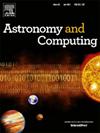MAR: A Multiband Astronomical Reduction package
IF 1.8
4区 物理与天体物理
Q2 ASTRONOMY & ASTROPHYSICS
引用次数: 0
Abstract
The Multiband Astronomical Reduction (MAR) is a multithreaded data reduction pipeline designed to handle raw astronomical images from the Southern Photometric Local Universe Survey, transforming them into frames that are ready for source extraction, photometry and flux calibration. MAR is a complete software written almost entirely in Python, with a flexible object-oriented approach, simplifying the implementation of new moduli. It contains a Python package, mar, with all essential operations to be used, a server where the pipeline resides, an interface that allows users to navigate quickly, and a database to store all data as well as important information and procedures applied to the images. MAR is now regularly used to process data from the Southern Photometric Local Universe Survey, but its methods may be used for developing other multiband data reduction packages. This paper explains each pipeline modulus of MAR and describes how its routines work.
一个多波段天文压缩包
多波段天文压缩(MAR)是一个多线程数据压缩管道,设计用于处理来自南方光度局部宇宙调查的原始天文图像,将它们转换为准备进行源提取、光度测定和通量校准的帧。MAR是一个几乎完全用Python编写的完整软件,采用灵活的面向对象方法,简化了新模块的实现。它包含一个Python包(mar),其中包含要使用的所有基本操作,一个管道驻留的服务器,一个允许用户快速导航的界面,以及一个存储所有数据以及应用于图像的重要信息和过程的数据库。MAR现在经常用于处理来自南方光度局部宇宙调查的数据,但它的方法可能用于开发其他多波段数据压缩包。本文介绍了MAR的每个管道模量,并描述了它的工作原理。
本文章由计算机程序翻译,如有差异,请以英文原文为准。
求助全文
约1分钟内获得全文
求助全文
来源期刊

Astronomy and Computing
ASTRONOMY & ASTROPHYSICSCOMPUTER SCIENCE,-COMPUTER SCIENCE, INTERDISCIPLINARY APPLICATIONS
CiteScore
4.10
自引率
8.00%
发文量
67
期刊介绍:
Astronomy and Computing is a peer-reviewed journal that focuses on the broad area between astronomy, computer science and information technology. The journal aims to publish the work of scientists and (software) engineers in all aspects of astronomical computing, including the collection, analysis, reduction, visualisation, preservation and dissemination of data, and the development of astronomical software and simulations. The journal covers applications for academic computer science techniques to astronomy, as well as novel applications of information technologies within astronomy.
 求助内容:
求助内容: 应助结果提醒方式:
应助结果提醒方式:


